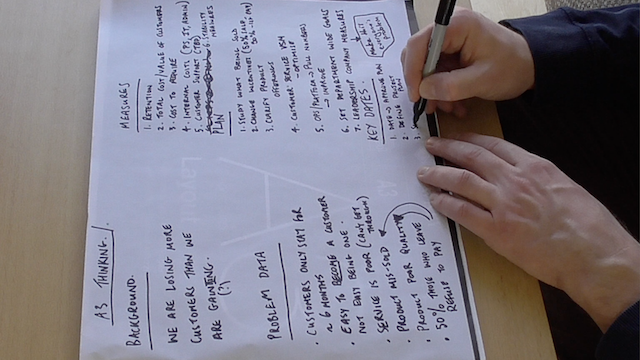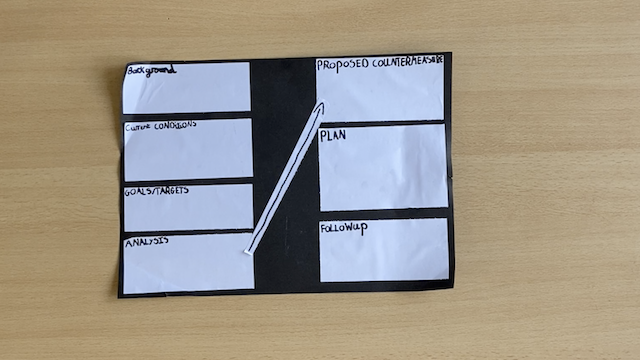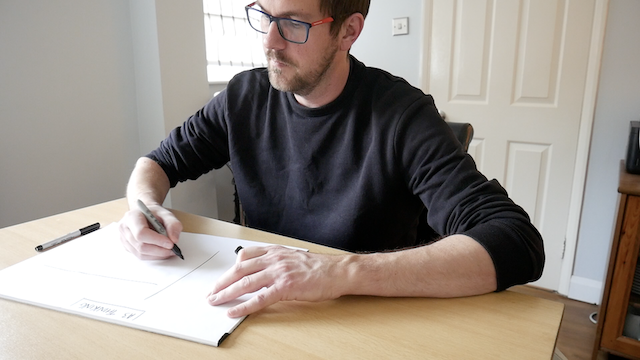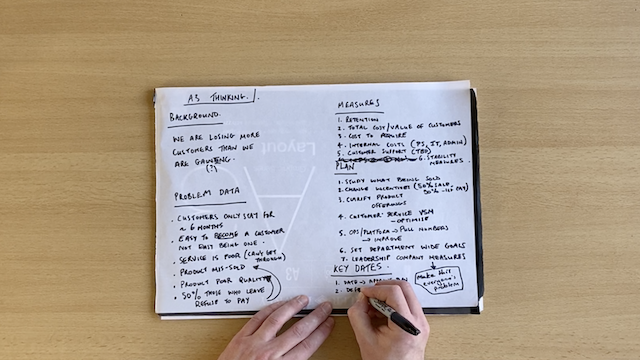
In this article and video I share ideas about how I use A3 thinking.
A3 Thinking originated at Toyota as a way to solve problems.
The concept is simple, but the execution of A3 Thinking can be tricky. Here’s a video, or read on for more.
The template I use is different to the original A3 Thinking templates which are widely available on the web.
I’ve shared my ideas in this post so you can create your own if it resonates with you.

The power of A3 thinking is that a sheet of A3 paper is just enough real estate to get the essence of the problem captured and next steps defined.
It’s not about creating detailed analysis nor complicated, convoluted plans either. It’s about moving quickly and carefully, but not being bogged down with so much thinking that nothing gets done.

It’s rapid, collaborative and very visual, which is why I really like this concept.
The exercise of using A3 Thinking isn’t overly time consuming, although it may take a while to diagnose and study the problems fully and tease out the facts.
When many people use techniques like this to look at “problems” or “things to improve” they often don’t get to the root cause of the problem. They often merely get opinions and wishes and thoughts. These are useful but not helpful when you’re trying to solve a problem.
To solve a problem we must fully understand the problem in the first place – and that needs evidence and data.
Grab some A3 Paper, a sharpie and let’s go.
The Sections
I use 5 core sections; Introduction, Problem Data, Measures, Plan, Key Dates.
Introduction
The introduction is fairly simple — introduce the goal and problems being investigated.
This could be as simple as “We are losing more customers to the competition” or “our platform keeps falling over” or “I don’t have enough time to create the 100 videos I want to”.
Be as clear and specific about the problem space.
This first step is important because you want to define the problem. There are no hard and fast rules. Too narrow and you may miss a good solution. Too broad and you could spend forever gathering the data.

I like to fully understand the problem. As you define problem data (next step) you may find the problem statement itself becomes more defined and you must refine it— that’s certainly my experience.
Problem Data
Here’s where we get data.
This could be qualitative data (opinions, ideas, thoughts, observations), although you know my view on using qual data alone, or quantitative (numbers, trends, etc). Ideally you’ll have some of both.
This is probably the most important section of the A3 Thinking template so spend time here. Ideally you will capture absolute evidence and facts, not just opinions from loud or influential people. This will require skill, care and great communication skills.
It is not a witch hunt, but you are trying to work out what’s causing the problem.

In an example of losing customers we want to gather:
- Numbers of customers who leave
- How long do they stay as a customer before leaving?
- Do we know, honestly, why they are leaving?
- How much does it cost for us to acquire customers?
- What is the entire customer lifecyle value (as in, not just the initial sale)?
- Are there patterns?
- What financial impact are these losses having on the business?
- What do staff think are the main reasons?
Identify as many problem data sets as you can. Try to be sure we’re solving the right problems.
Measures
As with all work we should be certain it is adding to the business results.
Are we adding business value or are we detracting from it?
I see so many people doing “busy” work that is adding no value. Wasteful, time consuming work that doesn’t address a problem. Often this is because managers and leaders have not defined the problem well enough, but also because nothing is getting measured.
Initiatives and work are kicked off with no real link to business measures.

Measures work best when they are trends and real time and associated to the purpose of your business.
That way we can see data points over time (single snapshot data points in business are rarely helpful for making informed decisions. We can see real time numbers which are helpful to see where we are now – but as mentioned, becareful about making decisions on current data points unless you have the trend over time also.
We can also be sure that when we are using these measures they are directly related to business results, or a solid proxy.
It’s hard to study and gather this data – many companies simply don’t have it.
The main reason for requiring this data is to ensure that when you start trying to solve the problem, you can see the affect the changes you’re making are having on the people, system and ultimately, the delivery of business results.
If we have no data to demonstrate a problem, how will we know that we’ve fixed it? Or did we make it worse? Or have we solved the wrong thing?
This should be captured in the problem data section. No data, no real evidence of a problem….
The Plan
Once we have the data and measures we can now formulate a plan.
The power of A3 Thinking is that there isn’t enough room for a deep, rich, PMO style plan. Good. Problem solving often means moving quickly, so a simple, easy, next-step based plan makes sense.
In this section write down the next steps. What can you, or the team, do next?
What is the most obvious next step and can it be run quickly and carefully?
How can you run a small experiment to address the problem?
The plan should likely include two core aspects:
- What the activity is
- Who is going to own it
Key Dates
The next step is to get down some key dates to operate within.

Be careful though, made up rushed deadlines will drive the wrong behaviours. But no date means you may never get to anything useful.
Dates also give us milestones and markers to track against and can be useful to measure progress but also retrospectively see the good work done in a short time.
I like shorter dates that drive action. After all, if there is a problem and we’re keen to solve it, why would we then procrastinate about it.
Conclusion
So there you have it, my A3 Thinking problem solving approach. There are many other ways to solve problem, but A3 Thinking is such a powerful lightweight approach that it makes sense in many situations.
I probably use this approach in 99% of my work when solving problems or building strategies.
The hard part is always in gathering the problem data for the A3 Thinking.
Many managers and leaders are responsible for creating the problems in the first place, so when you try to gather data and solve these problems, you face a lot of defensiveness, ego and politics.
Still, this is where the biggest gains are. Instead of shifting the burden of problems, not solving them fully or creating busy work from faulty data, you can blast through this and truly release agility by fixing the very real problems.
Tread carefully though. Some managers and leaders thrive on having problems lying around. It keeps them busy and offers an excuse when things don’t go to plan 🙂
Until next time.

